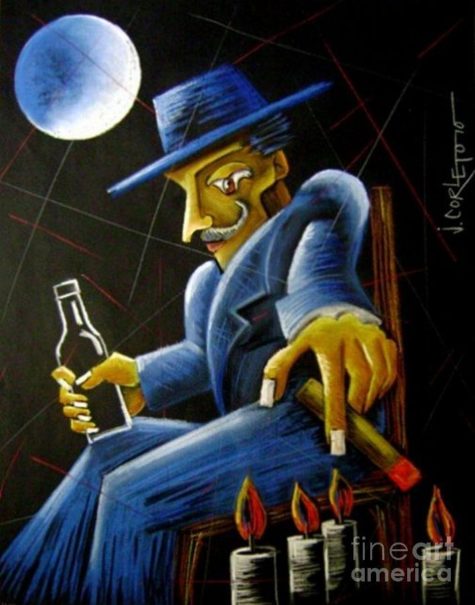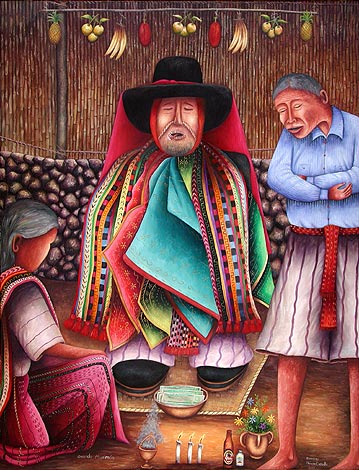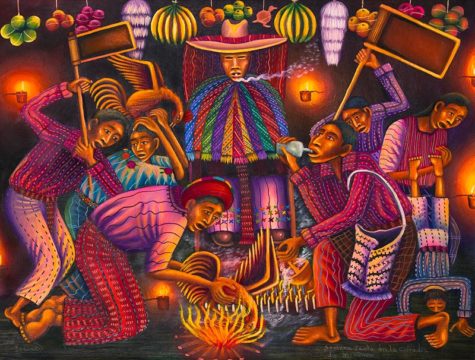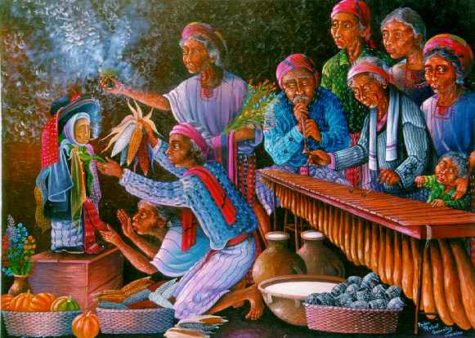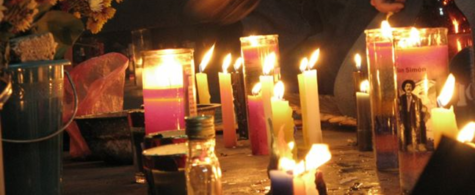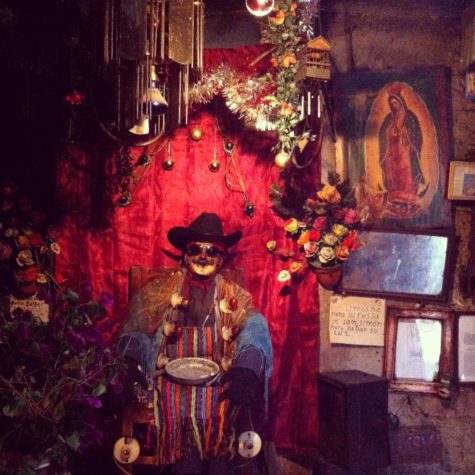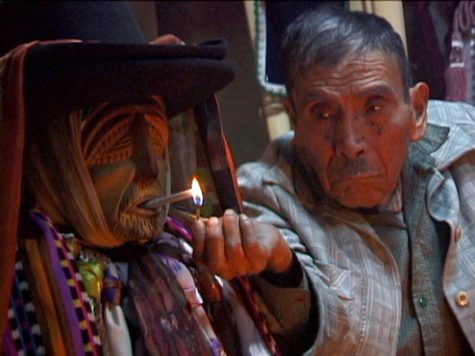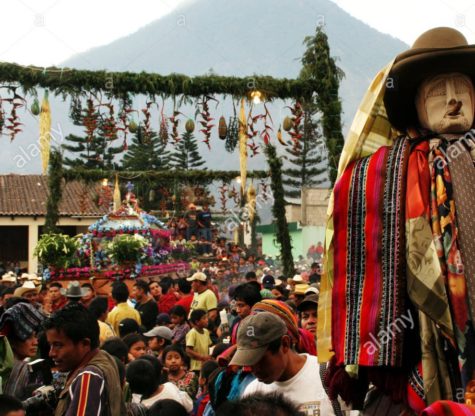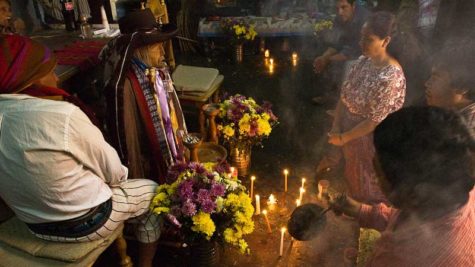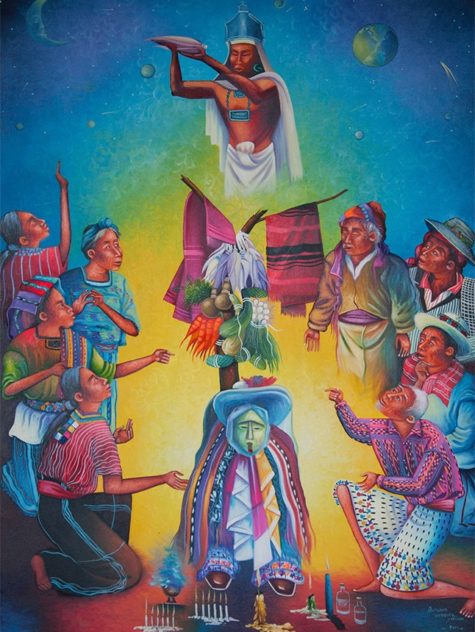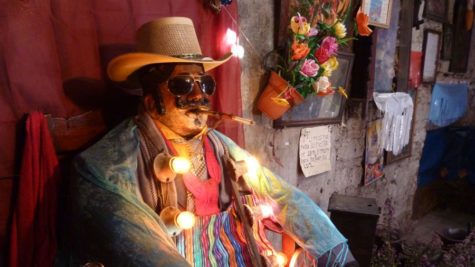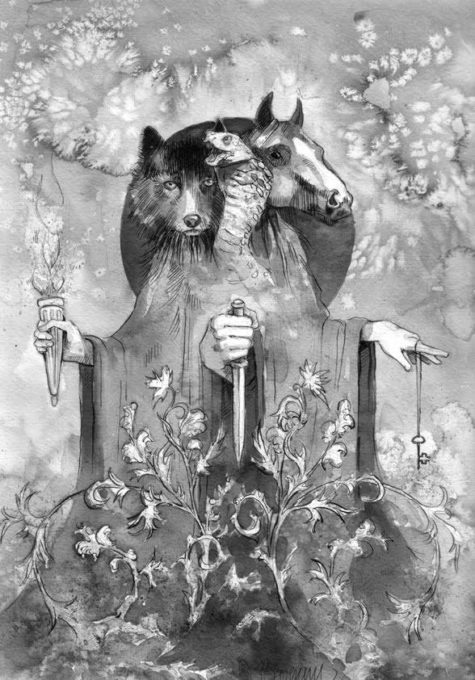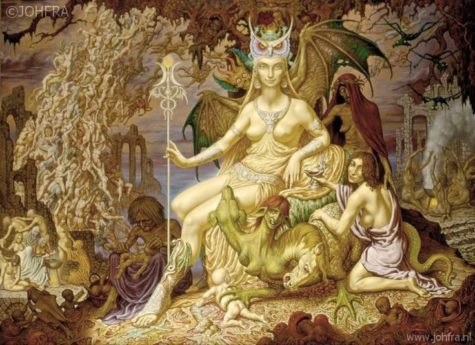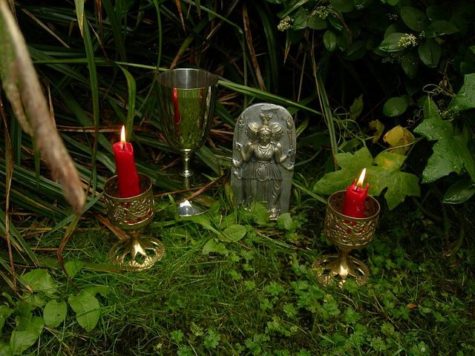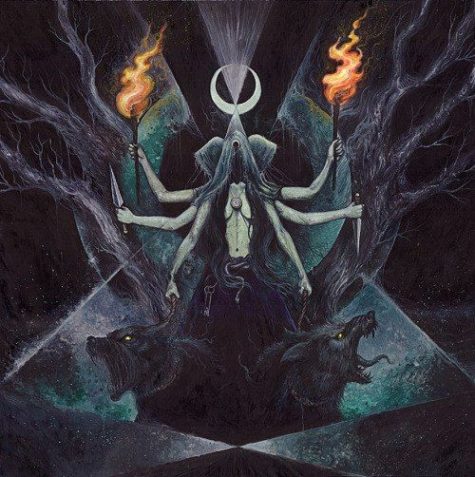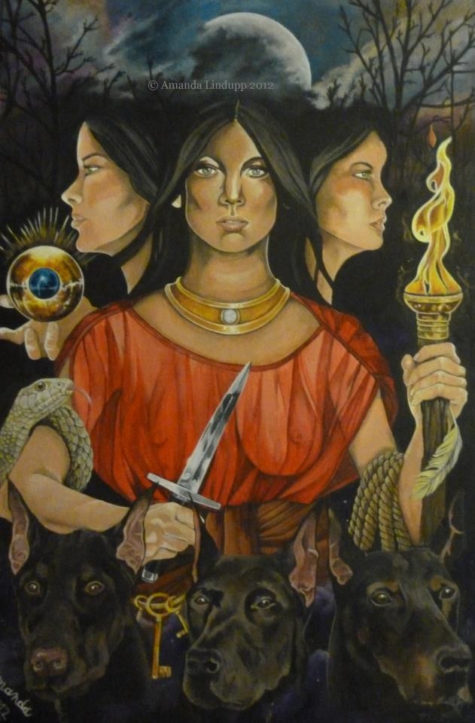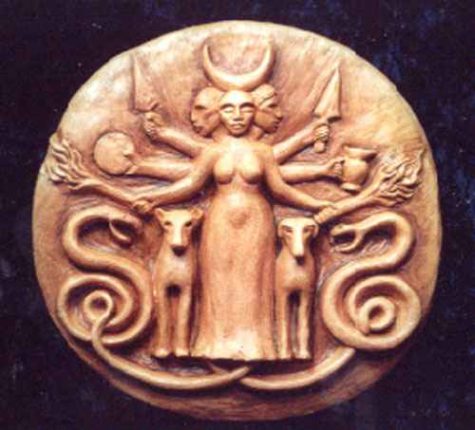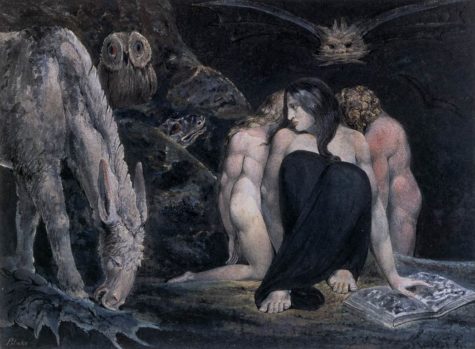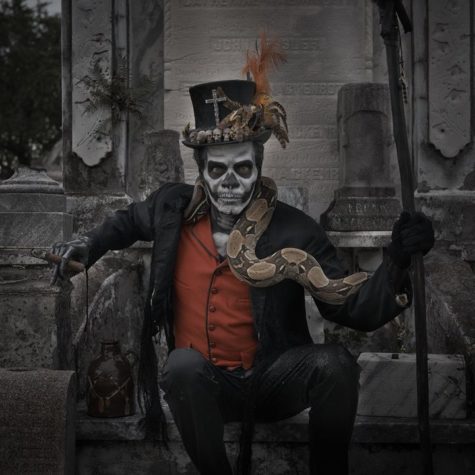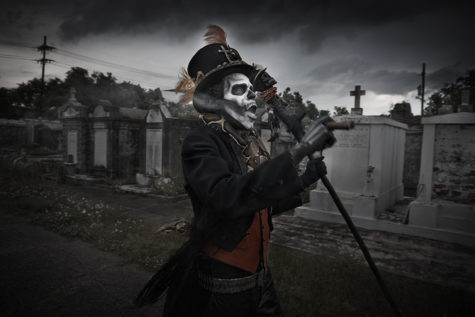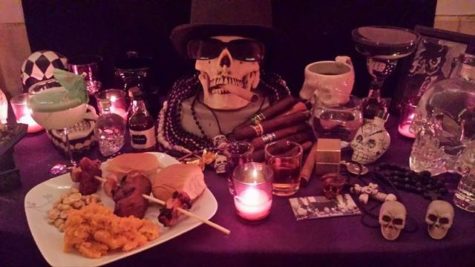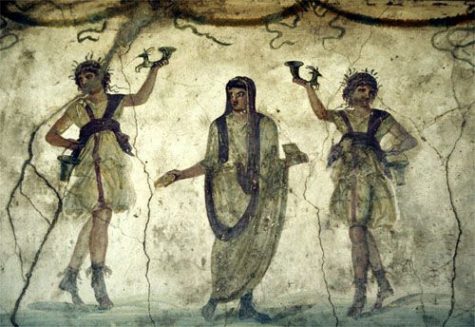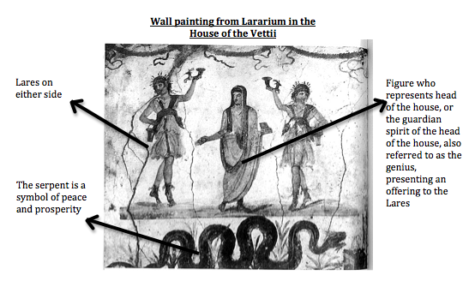Crossroad Spirits
- Titles: The Old Man; The Uncle
- Also known as: Maam; Don Pedro; Saint Simon; Brother Simon; Brother Peter
- Pronounced: Mah-shee-mon
- Origin: Maya
Maximón is a master shape shifter, reconciling religious traditions and offering guidance to indigenous Mayans who venerate him in Guatemala. He is also a heavy drinker and smoker.
Maximón, also known as San Simón, is an important Mayan folk saint in Guatemala represented by a dressed up wooden effigy sitting on a chair who, unlike other saints, smokes cigars and drinks alcohol. Today Maximón is actively worshiped as part of what we could refer to as “folk Catholicism“, especially in the highlands of Guatemala.
His visitors travel from near and far to come see him and ask for protection, money, to be cured or even find a husband. Maximón receives everyone – men and women, villagers and urban dwellers, prostitutes and entrepreneurs – who come with many offerings including tobacco, liquor, money and tortillas (his favorites).
Christian missionaries who came to Guatemala to convert the local people encountered the primordial Mayan deity Maam, Lord of the Universe. Attempts to syncretize him to Saint Simon backfired. Instead of the Mayan god fading discreetly into the identity of the saint, Maximón, as he became known, took on a whole new life and personality of his own: defiant, rambunctious, anti-social. The Church then attempted to syncretize him with Judas Iscariot or even Satan, but it was too late. All they did was enhance Maximón’s outlaw image and make his devotees love and admire him even more.
Maximón’s appearance varies greatly by location. While he’s popularly depicted as a man in a suit and hat, this isn’t a constant. In Santiago Atitlán, he wears colorful garlands and scarves, while in Zunil, he wears sunglasses and a bandanna.
Although his wardrobe has been updated and modernized, Maximón is an ancient, primordial spirit. He has survived numerous attempts to suppress his veneration and is now more popular than ever, venerated throughout the Americas and Europe.
He is generally benevolent, associated with healing, prosperity, and protection. In Guatemala, Maximón is traditionally invoked for protection for or from anti-government forces. Nothing is beyond his assistance or outside his jurisdiction. Maximón is said to represent both light and dark, and to be a trickster. He is both a womanizer and a protector of couples. Be wary.
Maximón is a crossroads spirit. He mediates between the living and the dead, people and spirits. He serves as a bridge between malevolent and benevolent spirits. Maximón is an extremely responsive spirit who works for comparatively modest offerings.
He makes people’s dreams come true. He challenges believers. He heals. He helps overcome obstacles. He stands against injustice. He dances the night away. He brings wealth and success. Fertility and prosperity. He wins the heart of women and protects from infidelity. In fact, he is the lord of sexuality standing for all unresolved matters of a moral nature.
Legend says that one day he was caught sleeping with the wives of the village men who had supposedly gone to work. Furious, they cut his legs and arms off. So Maximón also makes mistakes, which makes it easier for people to relate to him. Sometimes when he brings justice to a person, it is even at the expense of another. Thus, he sits at a crossroads between being both a deity and a trickster, a friend and a fiend.
Maximón may indicate his presence via the smell of cigar smoke when no cigars are present. He visits in dreams.
Spells, Rituals and Operations:
Maximón is invoked in numerous magickal spells, rituals, and operations.
- Protection of your business
Place his image in your shop or store to stimulate better business and for luck, money, and protection. Maximón foils and/or punishes shop-lifters and thieves
- Abusive people or situations.
If someone abuses you, whisper your needs directly into the ear of Maximón’s image. Place the person’s photo under Maximón’s left foot, or write a note and place it there.
- Requests for love.
Coil a rope around his image (even around his neck!) to show him that you need his help capturing someone’s heart or alternatively, for hobbling competing suitors. Whisper in his ear to tell him what you need.
- Marital issues.
Wrap a rope around his image to keep your spouse from running off with another.
- Maximón is invoked to heal addictions.
He will accept request on behalf of others, especially addicts. He may be invoked on behalf of someone else who cannot or will not ask him themselves. It is not necessary to tell the person that you have requested Maximón’s blessings on their behalf. The deal is between you and Maximón. Make offerings and tell him what the other person needs. However, even if the other person reaps the blessings, Maximón is doing YOU the favor; YOU must fulfill any vows or promises made.
Colors and Candles
An elaborate color scheme is used to communicate with Maximón. Those who are experienced candle-burners may choose to retain their own candle color associations, but the following color chart is commonly used to communicate desires and petitions to Maximón. Burn the color candle that closest represents your needs:
- Black: Protection from envy, jealousy, enemies, and the deliberately cast Evil Eye
- Blue: For good luck, employment
- Brown: Protection from resentment and the accidentally cast Evil Eye
- Green: Business, prosperity, cash
- Light Blue: Cash, travel, education, and happiness
- Pink: Hope, health
- Red: Love, fidelity
- White: Protection of children
- Yellow: Protection for adults
Offerings:
Hats, silk scarves, flowers (he likes bougainvilleas, carnations, and gladioli), fruit, tobacco products especially cigars, copal incense, water, Coca-Cola, tequila, aguardiente. An elaborate offering when you really need a big favor or as a fulfillment of a vow is forty candles plus copal incense.
Images:
The oldest images of Maximón consisted of masks and mysterious wrapped bundles. However a modern votive image has also evolved possibly based on the only known existing photograph of shaman, wizard, and Maximón devotee Francisco Sojuel (died circa 1907), credited with crafting the first modern Maximón mask. This image depicts Maximón as a mustached man wearing a black suit and a Stetson or similar hat. He is usually, but not exclusively, depicted sitting.
The modern image closest to his ancient one consists of a bundle of fabric topped with one or more Stetson hats.
The name Maximón is often interpreted as deriving from Maam and Simon. Another theory suggests that it derives from Maam and ximon, a Mayan word that may refer to a bundle or the act of “tying up,” essentially creating a bundle. The use of bundles as sacred objects is not uncommon in indigenous American spiritual and magickal traditions.
Votive images range from pocket-size to life-size. The mouth of his statue may be open so a real cigar may be inserted.
Alternatively, the statue may be designed so that the cigar can be placed in his hand. Ashes and stubs from offerings are collected and preserved. Placed in a small charm bag they serve as amulets, allegedly bringing good luck. Sometimes tubes are inserted into statues so Maximón can actually “drink.” Liquor passing through his system is then reserved for ritual use.
Maximón often accumulates an extensive wardrobe. He is a fastidious spirit whose clothes must be kept clean. The rinse water used when hand-washing his clothes may be preserved as Holy Water, or magickally charged water. It is said to have magickal and healing powers.
Festivals and Sacred Sites:
Guatemalan festivals dedicated to Maximón coincide with Holy Week, culminating on Good Friday.
One of the aspects of Maximón is that he can appear in any form. During Easter week he takes on the form of Judas Iscariot, who in betraying Jesus became the catalyst who put into action the events ended in the crucifixion of Jesus. Judas (Maximón) then hangs himself.
What has sometimes been described as a lynching in Guatemala, is actually a Easter Week re-enactment of the crucifixion where the hanged man is Maximón in his guise as Judas Iscariot. The Tz’utuhil Maya workers on the fincas [plantations] on the coastal side of the Volcano Atitlán have brought their customs with them from the highlands in Santiago Atitlan.
Maximón is the subject of innumerable home shrines, but his major public shrine is in Lake Atitlan, Guatemala.
In Santiago Atitlán, Maximón’s effigy resides in a different household every year. His image is normally only taken out of this house during Holy Week, whereafter it will change households, but is on display year-round due the popularity of pilgrimages. The effigy of Maximón in Santiago stays with one of five families, who are members of a religious brotherhood looking after the saint. He stays there for an entire year, and is moved during the procession of Holy Week.
Maximón lives in a room within the family home, and he is accompanied by two chosen family members at all times. Yep, you read that right: at all times…for a year. The chosen two won’t work for a year; guarding Maximón and spending time with him is their full-time job for 365 days. They stay by the altar year-round, drinking and smoking alongside it.
But that’s not all. These guys are also there to pass on offerings from visitors to the effigy, which are usually in the form of cigarettes, cigars, money, tobacco, and moonshine. Visitors can then ask for good health, good crops or marriage counsel. The two guardians usually put on one of Maximón’s two cowboy hats and speak to him in a local dialect.
It looked like they were having a casual chat, the guardian resting his arm on Maximón’s shoulder in a brotherly way, stopping his speech every once in a while, as if listening for Maximón’s reply, or simply to tip the ash off his cigarette.
If you want to share a drink with Maximón, you can do that too. He likes the local ‘Quetzalteco’ and his guardians will pour it through Maximón’s mouth. Because he’s hollow, the liquid flows through him and out between his leather boots. It’s then caught in a glass and drunk by the guardians or other family members who happen to be passing through. Like some kind of spiritual keg you can tap. This means the guardians are always drunk, or at least sleeping off a big drink. All the time.
In the town of San Andrés Itzapa, there is a large temple to Maximón. Here, offerings such as corn, flowers, and candles are burned in public by Shamans for the deity. Pilgrims travel to this temple from all across Latin America.
Maximón is more than just a saint. He represents the resilience of Mayan people in the light of their struggles against oppression, a symbol of hope and transformation.
Myths and Legends:
According to some legends, Maximón was an elder who reincarnated to protect his people. During the Spanish Conquest, an elder named Ri Laj Mam, upset by the evils of the Spaniards, encouraged his people to start a rebellion. He was eventually executed, but returned to life in the form of a judge named Don Ximon, who fought to give land back to the native people of Guatemala.
Another legend states that Maximón was hired by traveling fishermen to protect the virtue of their wives. Instead, Maximón disguised himself and slept with all of them.
In Santiago Atitlán, an alternative tale says that Maximón was never a man, but a wooden figure created by Shamans to defend the village from witches. However, Maximón used trickery to harm the people of the village, so the Shamans twisted his head around and broke his legs to stop him. He then did his job properly and protected the people of the town from evil.
Sources:
Hekate is an exceptionally powerful spirit. She holds dominion over life, death, regeneration, and magic. She rules wisdom, choices, expiation, victory, vengeance, and travel. Hekate guards the frontier between life and death. She is an intermediary between the spirit world and that of humans. She is the witness to all crimes, especially those against women and children.
Hekate (Hecate) is Queen of the Night, the Spirit World, and Witchcraft. Her epithets include:
- She Who Works Her Will
- The Most Lovely One
- Influence From Afar
- Three Headed Hound of the Moon
- The One Before The Gate
- Light Bringer
Although today most associated with Greek mythology, her name, meaning “influence from afar,” acknowledges her foreign origins.
Generally believed to have first emerged in what is now Turkey, she was not an obscure goddess. Hekate was at one time chief deity of Caria, now western Turkey, and was eventually widely worshiped throughout Europe, Western Asia, and Egypt. Records of formal worship date from eighth century BC to the fourth century AD, although as magic fell from grace she became an increasingly disreputable spirit. All Hekate’s myths clearly identify her as a witch and matron of magical arts.
Hekate is renowned for her expertise with plants and her knowledge of their magickal and healing powers. A famed magickal garden was attached to her temple in Colchis on the Black Sea, now in modern Georgia. Some scholars suggest that an ancient Greek women’s guild, under the divine matronage of Hekate, once had responsibility for gathering and storing visionary, hallucinatory and poisonous plants. The same work in Greek indicates “pharmacist,” “poisoner,” and “witch.”
Petitioning Hekate
Hekate is a goddess of life, death, regeneration and magick. She rules wisdom, choices, expiation, victory, vengeance, and travel. She is witness to every crime.
- She is invoked for justice, especially for sexual crimes against women and girls.
- Hekate is invoked when justice is not forthcoming from other channels.
- Hekate has the power to grant or deny any mortal’s wish.
- She may be invoked for protection for dogs and from dogs.
- Hekate is petitioned for fertility, especially for female children.
- She brings victory in battle.
- Hekate may be invoked for healing, especially if medical solutions have failed.
- She may be petitioned for swift, painless death.
- Hekate can banish ghosts – or produce a ghost infestation.
Hekate typically responds to petitions via visions and dreams. If lost at a crossroads, literal or metaphoric, invoke her name and then pay attention to signs from her. She can be a shadowy, oblique goddess: her response may be subtle. Look for her animals: snakes, dragons, cats, and especially dogs.
- Favored people
Midwives, witches, healers, herbalists, dog lovers and rescuers. She is the matron of women in general and protects those who ride horses.
A Living Altar
Hecate is most famous today as a Dark Moon Spirit and Queen of Witches. Those are but two aspects of this multifaceted deity. Hecate was once the chief deity of the Carian nation, now in Western Turkey. She is matron of the city of Istanbul. She has dominion over life and death and makes the journey in between, indicating her power as a healing deity. Hecate is matron of midwives and herbalists.
Her priestesses (the most famous was Medea) were trained herbalists. Those in need of healing or solace journeyed to the gardens attached to Hecate’s shrine in Colchis on the Black Sea, home of the Golden Fleece pilfered by the Argonauts.
Hecate’s assistance may also be accessed by building a living altar in her honor. Plant a garden outdoors or create a living altar inside with potted plants. Add some or all of the following:
- Dog roses,
- Garlic,
- Lavender,
- Mandrake,
- Queen of the Night,
- Roses,
- Thorn apple,
- Tuberoses.
Hecate’s trees include:
- Black poplar
- Date palm
- Pomegranate
- Willow
- Yew
Place votive images of Hecate, together with her favorite creatures – dogs, dragons, and snakes – in the garden. To petition Hecate directly or to receive spontaneous magical inspiration regarding your healing needs, sit in or beside your living altar in the dark.
To Summon Hekate
Hecate, Queen of Witches, maintains office hours only at night: formal petitions and invitations must be offered after dark. A particularly ancient spirit, the only source of illumination she favors is fire.
Summon Hecate at night by a three-way crossroads. Ideally, light your way with a mullein torch. Offer her garlic, lavender, and honey. If you have a dog, bring it with you. Keep an eye on the dog; it’s likely to perceive Hecate before you do.
Why would you wish to contact Hecate?
Because she can teach you to do anything with magic. Because she can grant you enhanced psychic powers, fertility, romance, protection, freedom from illness, and magical restitution for any crime committed against you.
Hekate has been with us for at least three thousand years.
She was a liminal goddess who was present at all the boundaries and transitional moments in life. She was also an ‘evil-averting’ protector and guide. Her triple form emphasized her power over the three realms, these being the heavens, sea, and earth. Her primal nature was seen in the many animal heads she was depicted with, each emphasising different qualities of her manifold character.
Some of her well known titles include:
- Chthonia – earthy one
- Dadouchos – torch bearer
- Enodia – of the ways
- Kleidouchos – key bearer
- Kourotrophos – child’s nurse
- Phosphorus – light bearer
- Propolos – companion
- Propylaia – before the gate
- Soteira – savior
- Triformis – three bodied
- Trioditis – of the three ways
To enhance your ability to summon Hecate, try this:
Dry dandelion roots, then slice and pierce them to create beads, forming a ritual necklace to wear when calling Hecate. Call – or think – Hecate’s name as you pierce, string, and knot each bead. For best results, string the necklace at night by firelight.
Another way to enhance your relationship with the Queen of the Night is to practice the Silence of the Night Meditation. It’s a very simple yet profoundly powerful meditation, especially when practiced for an extended period of time.
Manifestations
Hekate has been known to assume the shape of a black cat, a bear, a pig or a hen but most typically manifests as a mature woman or black dog. She has a particularly strong bond with dogs. Even when manifesting in human form, Hekate is usually accompanied by hounds. Somehow there will be a canine reference. When manifesting as a woman alone, Hekate often circles in the manner of a dog.
Artistic renderings of Hekate usually attempt to capture her spiritual essence. She may be depicted with three bodies, each facing a different direction. One hand holds the knife that is the midwife’s tool, another holds a torch to illuminate the darkness, the last bears a serpent representing medical and magical wisdom. Sometimes Hekate is depicted with a woman’s body but three animal heads – those of a dog, a horse, and a lion.
Hekate, Queen Witch, is a shape-shifter supreme. While her usual manifestations are as a black dog or mature woman, she may manifest as a haggard, decrepit crone or a sexy, elegant, seductive woman. She even has an occasional mermaid manifestation. She may wear snakes in her hair. Every now and then, she appears as a black cat, snake, or dragon.
Sacred to Hekate
Hekate’s sacred time is black night. All her festivities and ceremonies are held after dark, the only acceptable illumination is candles or torches. She only accepts offerings and petitions at night. Hekate is identified with the Dark Moon, the time of her optimum power.
The last day of each month is dedicated to Hekate. She also shared a festival with Diana on August 13th in Italy. Modern Wiccans, for whom Hekate is an important deity, celebrate November 16th as Hecate Night of the Crossroads.
- Animals: Black ewe lambs, Boar, Bull, Cats, Cock, Cow, Dogs, Dragons, Fish, Goats, Horses, Lions, Mice, Mullet (fish), Polecat, Rams, Serpents, Toads, Wolf
- Attributes: Key, Cauldron, Broom, Torch, Knife
- Bird: Stork
- Color: Black, also Red, White, Yellow
- Emblem: Star and crescent moon
- Food: Eggs, Honey, Amphiphon Cakes (a cheesecake with lighted candles stuck into it)
- Fruit: Pomegranate
- Minerals: Copper, Gold, Loadstone, Meteorite, Sapphire
- Mount: Dragons pull her chariot
- Number: Three
- Planets: Moon (especially the dark moon), and Sirius, the Dog Star
- Plants and herbs: Aconite, Anise, Belladonna, Garlic, Grain, Henna, Lavender, Mandrake, Onion, Poppy, Saffron,
- Symbols: Dagger, Keys, Horned Crescent, Pegasus, New Moon, Three-Way Crossroads, Trident, Twin Torches
- Trees: Apples, Black poplar, Date palm, Oak (leaves), Pomegranate, Willow, Yew
Her sacred place is the crossroads, specifically three-way crossroads. Among her name is Hecate Trivia. That doesn’t indicate that Hekate is trivial or that worshiping her was a trivial pursuit: Trivia literally means “three roads.” Hekate is Spirit of the Crossroads: her power emanates from their point of intersection. Hekate’s image was once placed in Greek towns wherever three roads met.
Hecate is the Goddess of the dark of the moon, the black nights when the moon is hidden. She was associated with deeds of darkness, the Goddess of the Crossways, which was held to be ghostly places of evil magic, an Awful Divinity,
“Hecate of hell
Mighty to shatter every stubborn thing.
Hark! Hark! Her hounds are baying through the town.
Where three roads meet, there she is standing.”
Rituals
Hekate’s ancient devotees held dinners in her honor, known as Hekate Suppers. Foods associated with her were prepared. The entree was usually fish, especially red mullet. Devotees feasted and celebrated. Offerings and leftovers were placed outside the door or at a crossroads for Hekate and her hounds.
- The last day of each lunar month is dedicated to Hekate.
- Friday the 13th – particularly if it falls in the month of August.
- November 16th is Hekate Night
- August 13th, in Italy, a festival is shared between Diana and Hekate
Even way back when, cynics scoffed that food placed outside was actually consumed by feral dogs and homeless people without realizing that this is Hekate’s intent: this is one way she accepts offerings. (The Church was still trying to eradicate this ritual as late as the eleventh century.)
Smaller, private offerings may be left at a crossroads, too:
- Place offerings on a plate or flat stone and leave them at a crossroads after dark.
- Make your invocation and then walk away without looking back.
- Do not return for the plate, or any part of the offering, but consider it part of your gift.
Offerings can include the following:
- Eggs
- Garlic and honey (especially lavender honey)
- Croissants and crescent shaped breads and pastries
- Candles
- Incense
- Images of dogs, especially black dogs
- Actions on behalf of dogs
Encountering or hearing a dog is an indication that your petition has been heard.
The Mythology
According to myth, Hekate once served as an Angelos, a messenger for the other deities. She stole Hera’s beauty salve to give to her rival Europa. Hera enraged, pursued Hekate, who fled first to the bed of a woman in childbirth, then to a funeral procession, and finally to Lake Acheron in Hades where she was cleansed by the Cabeiri. Hekate emerged more powerful than ever, a goddess of birth, death, and purification. She rules passages between realms of life and death and is thus invoked by necromancers.
Hekate is most prominent in Greek mythology for being the sole deity to voluntarily assist Demeter in her search for her abducted daughter, Persephone. Later, after Persephone eats Death’s six pomegranate seeds and is condemned to spend half the year in Hades, it is Hekate who accompanies her as Lady-in-Waiting. In some legends, she even becomes Hades’ co-wife. Ceberus, three-headed hound of Hades, may be Hekate in disguise.
Hekate becomes Persephone’s link to her mother and the land of the living. She guarantees that Death cannot break the bond between mother and daughter. Hekate is the Matron of Necromancy.
Hekate, daughter of the Titans Perses and Asteria, is older than the Olympian spirits. The eight-century BC Greek poet Hesiod writes that Hekate’s power dates “from the beginning.” Zeus was crazy about her: he eliminated all other pre-Hellenic deities (the Titans) but, having fallen madly in love with Hekate, he let her be.
Hekate is understood to be a triple goddess by herself, appearing as maiden, mother, and crone. She is also part of a lunar triplicity with Artemis and Selene, and also with Demeter and Persephone. Hekate dances in Dionysus’ retinue and is a close ally of Kybele.
Alongside her intense lunar identification, Hekate is also associated with the element of water: her first love affairs were with sea gods including Triton. Her great-grandfather was Pontus the Sea. Her maternal great-aunt was the sea monster Keto. Hekate is also related to the Gorgons and Sirens and may be the mother of Scylla, who was transformed into a sea monster by another relative, Circe. Prior to her transformation Scylla was a beautiful woman from head to waist, with canine hips terminating in a fish tale.
Hekate led a host of shape-shifting female spirits known as Empausas, whose usual manifestation was as a beautiful woman with one brass leg and one donkey’s leg; Hekate herself sometimes takes this form. The Empusas patrolled roads and apparently sometimes had fun terrorizing travelers. If one invoked Hekate, however, they left you alone.
Devotees feted the goddess by holding rituals known as Hecate’s Suppers at the end of each month at a crossroad. (The end of the month in lunar calendars corresponds to the Dark Moon, the new month begins with the first sighting of the new moon). The Church was still trying to eradicate Hecate’s Suppers in the eleventh century.
Post-Christianity, Hekate became among the most intensely demonized spirits, her very name synonymous with “witch”. Her symbols (toad, cauldron, broom) are inextricably linked with stereotypes of witchcraft. What were symbols of fertility became symbols of evil. Her sacred dogs were converted into the Hounds of Hell. This denigration served to camouflage Hekate’s origins as a deity of Healing and Protection.
An Interesting Historical Tidbit
Hekate was a goddess with an organized cult. In addition to Caria and Colshis, she had sanctuaries in Aigina and Lagina and a grove on the Aventine hill. She is the matron goddess and guardian of the city of Istanbul (previously called Byzantium and Constantinople).
Hekate is credited with saving that city from attack by King Phillip II of Macedonia in 304 BCE. His forces attempted to attack secretly during a dark moon but Hekate lit a crescent moon, creating enough light for the Byzantines to apprehend their danger and save themselves.
In gratitude, they began using her symbols (star and crescent moon) on their coins. The image still appears on the Turkish flag. The image predates Islam and was the official emblem of Byzantine Greeks.
Collected from various sources including Encyclopedia of Spirits
- Titles: Master of the Cemetery, Lord of the Dead
- Also known as: Bawon, Samedi, Bawon Sanmdi, Baron Saturday, Baron Sandi
- Colors: Black, also red and purple
- Day: Saturday
- Numbers: 3, 7, 21
- Classification: Lwa
- Consort: Madame Brigitte (Maman Brigitte)
- Venerated in: Haitian Vodou, Louisiana Voodoo, Folk Catholicism
- Feast: November 2
- Patronage: Death, tombs, gravestones, cemeteries, dead relatives, obscenities, healing, smoking, drinking, disruption, spirits
Baron Samedi is one of the loa of Haitian Vodou. He is the leader of the Barons and possibly the Gedes. He presides over a sprawling, confusing, complex clan of spirits. When people speak of the Baron, they tend to mean Baron Samedi. Baron Samedi literally means Baron Saturday, which may sound innocuous compared to Baron Cemetery, or Krininel, but Saturday was the one day when Christ was really truly dead, the day between the crucifixion on Friday and resurrection on Sunday. On Saturday, even Jesus must answer to the Baron, Lord of the Dead.
Baron Samedi is Grand Master of the Celestial Masonic Lodge of Vodou Spirits, a thirty-second degree initiated Mason. He is invoked to contact and communicate with the dead. He determines whether they can come visit or not. He may be petitioned to remove bothersome ghosts and invoked to ward off death.
He is noted for disruption, obscenity, debauchery, and having a particular fondness for tobacco and rum. Additionally, he is the loa of resurrection, and in the latter capacity he is often called upon for healing by those near or approaching death, as it is the only Baron who can accept an individual into the realm of the dead.
Baron Samedi spends most of his time in the invisible realm of vodou spirits. He is notorious for his outrageous behavior, swearing continuously and making filthy jokes to the other spirits. He is married to another powerful spirit known as Maman Brigitte, but often chases after mortal women. He loves smoking and drinking and is rarely seen without a cigar in his mouth or a glass of rum in his bony fingers.
Baron Samedi can usually be found at the crossroads between the worlds of the living and the dead. When someone dies, he digs their grave and greets their soul after they have been buried, leading them to the underworld.
He is a powerful healer and is especially sympathetic to terminally ill children. Baron Samedi rules the cemetery: no one can die until he gives permission for their grave to be dug. Baron Samedi is lewd, obscene, and vulgar, but he can be just and kind. He prefers that children live full lives before joining him in the cemetery.
Baron Samedi is the crossroads where sex and death meet. Spirit of the undying life-force, he may be petitioned for fertility. He is the guardian of ancestral knowledge and the link to your ancestral spirits. If one lens keeps popping out of your dark glasses, the Baron may be seeking your attention or offering his patronage.
Baron Samedi is syncretized to Jesus Christ as they share the symbol of the cross. It is possible that Baron Samedi’s associations with the cross may pre-date christianity. In Congolese cosmology, the cross is the symbol of the life cycle: death – birth – rebirth. He may also be syncretized to Saint Expedite, and with Saint Martin de Porres.
- Note:
Syncretized means to attempt to unite and harmonize especially without critical examination or logical unity.
Manifestations:
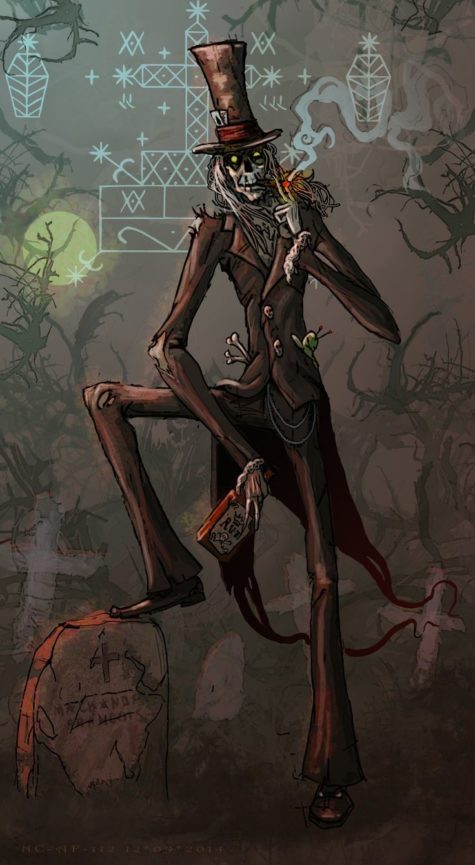 Baron Samedi manifests as an older, dark-skinned man in formal attire, dressed completely in black. He wears a black top hat, black suit, and may be smoking one of his beloved cigars. He wears impenetrable black sunglasses.
Baron Samedi manifests as an older, dark-skinned man in formal attire, dressed completely in black. He wears a black top hat, black suit, and may be smoking one of his beloved cigars. He wears impenetrable black sunglasses.
- The glasses may be missing a lens because he possesses two kinds of vision: he simultaneously sees the realms of the living and the dead.
- Alternatively his glasses have but one lens because a penis has but one eye and the phallus is his attribute (and because he loves sexual humor and innuendo.)
He is usually depicted with a top hat, black tail coat, dark glasses, and cotton plugs in the nostrils, as if to resemble a corpse dressed and prepared for burial in the Haitian style. He has a white, frequently skull-like face (or actually has a skull for a face), and speaks in a nasally voice. The former President for Life of Haiti, François Duvalier, modeled his cult of personality on Baron Samedi; he was often seen speaking in a deep nasal tone and wearing dark glasses.
- Favored People
Children; women seeking to conceive; funeral workers; grave diggers; those whose work brings them into contact with death.
Connection to other loas:
Baron Samedi is the leader of the Guédé, loa with particular links to magic, ancestor worship and death. Samedi is a loa of the dead, along with Baron’s numerous other incarnations Baron Cimetière, Baron La Croix, and Baron Kriminel. These lesser spirits, all dressed like the Baron, are all as rude and crude, but not nearly as charming as their master. They help carry the dead to the underworld.
Working with Baron Samedi
- Iconography: Baron Samedi’s throne is a chair chained to a cross. Images of Darth Vader are supposed to represent him (or just to decorate his altar; he likes toys)
- Attributes: Coffin; phallus, skull and crossbones; shovel; grave; black sunglasses; cross
As well as being master of the dead, Baron Samedi is also a giver of life. He can cure any mortal of any disease or wound, if he thinks it is worthwhile. His powers are especially great when it comes to vodou curses and black magic. Even if somebody has been afflicted by a hex that brings them to the verge of death, they will not die if the Baron refuses to dig their grave. So long as this mighty spirit keeps them out of the ground, they are safe.
He also ensures that all corpses rot in the ground to stop any soul from being brought back as a brainless zombie. What he demands in return depends on his mood. Sometimes he is content with his followers wearing black, white or purple clothes or using sacred objects; he may simply ask for a small gift of cigars, rum, black coffee, grilled peanuts, or bread. But sometimes the Baron requires a vodou ceremony to help him cross over into this world.
- Offerings
Black coffee, plain bread, dry toast, roasted peanuts. He drinks rum in which twenty-one very hot peppers have been steeped. Cigars, cigarettes, dark sun glasses, Day of the Dead toys, the sexier and more macabre the better; raise a skull and crossbones pirate flag for him, beautiful wrought-iron crosses are crafted in his honor.
- Veve
The veve or symbol for Baron Samedi is as follows:
Sources: Wikipedia and Encyclopedia of Spirits
- Also known as: Lases (Etruscan); Lassi
- Manifestation: Lares usually come in pairs, either in human form or as snakes.
- Sacred animal: Dog; Snake
- Origin: Italy
- Feast: Dec 23, The Larentalia
Lares are guardian spirits. Lares is plural but that’s fitting because they virtually always manifest in pairs. The singular is Lar. They are found inside the home, on the property they protect and also at crossroads. They make their home with the family they protect, usually dwelling by the hearth or beside the chimney.
The Lares themselves are usually depicted as dancing youths, with a horn cup in one hand and a bowl in the other. As progenitors of the family, they were accompanied by symbolic phallic serpents.
There were many different types of guardians. The most important are the Lares Familiares (guardians of the family), Lares Domestici (guardians of the house), Lares Patrii (guardians of the fathers) and Lares Privati (personal guardians). Other guardians were the Lares Permarini (guardians of the sea), Lares Rurales (guardians of the land), Lares Compitales (guardians of crossroads), Lares Viales (guardians of travelers) and Lares Praestitis (guardians of the state).
The Lar Familiaris protected all household members, free or slave, and was associated with a particular place, thus did not accompany a family who moved. Tradition holds that a family’s Lar would generously help those who honored him by devotionals and sacrifices. But the Lar would turn his back to those who would not offer him thanks or neglected him.
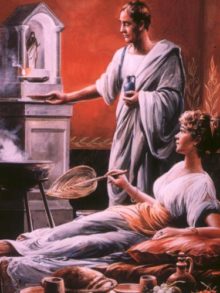 Presumed to be sons of Mercury and Lara, Lares are beneficent and friendly spirits, and deeply venerated by ancient Romans. In every house there was at least one little statue, and through these small statues, the Lare was presumed to take part in all that happened inside the house. Often a statue was put on the table during the meals, and other small statues were often placed in the higher places of the house, far from the floor, or even on the roof.
Presumed to be sons of Mercury and Lara, Lares are beneficent and friendly spirits, and deeply venerated by ancient Romans. In every house there was at least one little statue, and through these small statues, the Lare was presumed to take part in all that happened inside the house. Often a statue was put on the table during the meals, and other small statues were often placed in the higher places of the house, far from the floor, or even on the roof.
The Lares were worshiped in small sanctuaries or shrines, called Lararium, which could be found in every Roman house. They were placed in the atrium (the main room) or in the peristylium (a small open court) of the house. Here people sacrificed food to the Lares on holidays.
Care and attendance to domestic Lares could include offerings of spelt wheat and grain-garlands, honey cakes and honeycombs, grapes and first fruits, wine and incense. They could be served at any time and not always by intention: as well as the formal offerings that seem to have been their due, any food that fell to the floor during house banquets was theirs. On important occasions, wealthier households may have offered their own Lares a pig.
A household’s lararium, a shrine to the Lares Familiaris, usually stood near the hearth or in a corner of the atrium. A lararium often had the appearance of a cupboard or a niche containing a small statue, a niche painted on a wall, or a small freestanding shrine. Sometimes the Genius of the head of the household, pictured as a bearded or crested snake, or as a man with the fold of his toga covering his head, is depicted with the Lar.
Iconography: Lares are usually depicted as two young men with a watch dog; if depicted in serpentine form, then they may be crowned.
The Lares Compitales, the guardian spirits who protected local neighborhoods were housed in the crossroad shrines which served as a focus for the religious, social and political life of their local, overwhelmingly plebeian communities. Shrines were erected at crossroads. These shrines were usually open in all directions so that the Lares could travel as needed.
More about the Lares Compitales and their festival and feast days can be found here:
